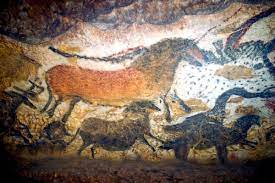u
The word 'PRE'in its own, means Before or Earlier while the adjective 'HISTORIC' Is a derivative of the noun History, which refers to past events.
u
Prehistoric art is also refer to as Parietal art, which is the
archeological term for works done on cave walls or large blocks of stone.
However, Art activities could be traced back
to the Early man, who wrote and drew on cave walls, rock surfaces, wood and
hides in about 11000-12000BC. Early man used different techniques to represent
images on such surfaces eg: scratching, engraving, incised drawings or
‘graffiti’ and painting. The
paintings were carried out with earth colours - red, yellow, black and the
white of chalk, mixed with animal fat to form a kind of oil paint. Others were
done with sharp and hard tools (probably hunting and farming implements).
Cave art was basically done for:
i. magical purpose
ii. as Objects of worship and
iii. for
Attracting animals, which are
subsequently killed.
iv. for decoration purpose
Such art were discovered at Altamira in
Northern Spain, Lascaux Cave in Southern France,Tassili and Tibesli, Plateau
between Southeastern Algeria and Western Libya.
u
However, period of prehistoric art sporadically spread over five phases
commonly referred to as stone ages. They are as follows
- Paleolithic age - old stone age (35,000 years B.C)
- Mesolithic age - middle stone age (25,000 years B.C)
- Neolithic age – New stone age (12,000 years B.C)
- Bronze age – modern age (4000 years B.C)
- Iron age – modern inventions (2000 years B.C)
.jpg)
Credit; Cave painting - Wikipedia
Abiola, M.S
Cambridge Certified Educator and Assessor/
Ohio State University, U.S.A Trained Art Teacher/
Official Judge for World COBIS Art Contest
Credit; Cave painting - Wikipedia
Abiola, M.S
Cambridge Certified Educator and Assessor/
Ohio State University, U.S.A Trained Art Teacher/
Official Judge for World COBIS Art Contest


